Welcome to the world of birds in Pennsylvania!
Here, you’ll discover a rich variety of species that call this state their home. From the vibrant American Robin and Northern Cardinal to the gentle Mourning Dove and majestic Great Blue Heron, Pennsylvania offers a diverse avian population for you to observe and appreciate.
Get ready to embark on an exciting journey, where you’ll learn fascinating details about these feathered creatures and deepen your understanding of the ecological importance they hold within this beautiful state.
Key Takeaways
- The American Robin, Northern Cardinal, Mourning Dove, American Crow, American Goldfinch, and Downy Woodpecker are common birds in Pennsylvania.
- European Starlings, House Sparrows, and Rock Pigeons are invasive species in Pennsylvania.
- The Red-tailed Hawk is a bird of prey found in Pennsylvania.
- Waterfowl such as Canada Geese and Mallards can be found in Pennsylvania, along with songbirds like the Carolina Wren, Blue Jay, Song Sparrow, Tufted Titmouse, White-breasted Nuthatch, Common Grackle, Eastern Bluebird, House Finch, and Black-capped Chickadee.
American Robin
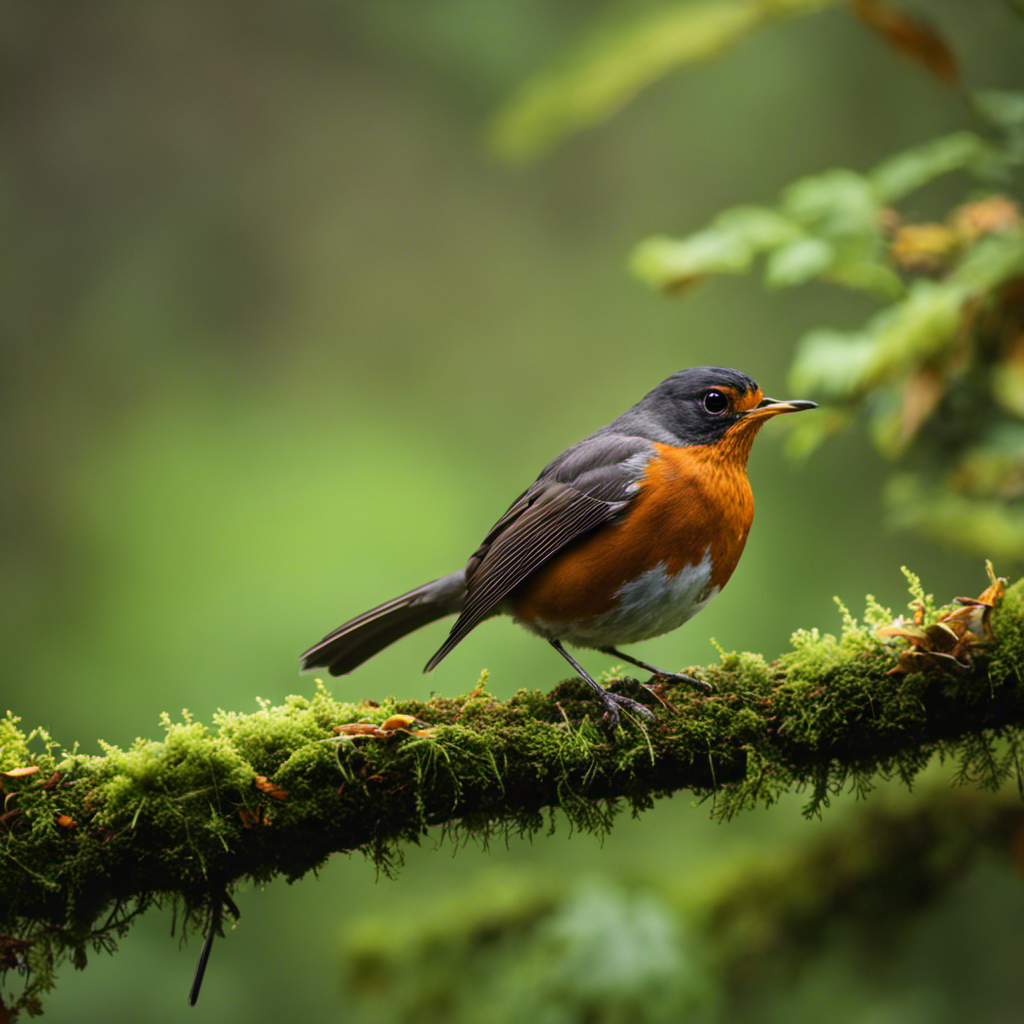
You can find American robins nesting in trees or foraging for worms on the ground. These birds have a wide habitat range, from forests to suburban areas. They prefer open spaces with short grass or lawns, as they rely on sight to find their prey.
American robins have a varied diet consisting mainly of insects, earthworms, and fruits. During the breeding season, they consume more insects to provide the necessary protein for their young. Speaking of breeding, American robins are monogamous and build cup-shaped nests made of twigs, grass, and mud. They typically lay three to five eggs and both parents take turns incubating them.
As for migration, American robins are known for their seasonal movements. In the spring, they travel north to breed, while in the fall, they migrate south to warmer climates. These migratory patterns ensure the availability of food and suitable nesting sites throughout the year.
Northern Cardinal

Spotting a vibrant red Northern Cardinal perched on a tree branch is always a delightful sight during a winter hike. These birds are known for their stunning plumage and are a common sight in Pennsylvania.
Northern Cardinals are known for their behavioral patterns, which include territoriality and monogamy. They’re highly vocal birds, with the males singing to defend their territory and attract mates. They’ve a wide habitat range, but they prefer dense shrubs and thickets, as well as forest edges and suburban gardens.
Cardinals are non-migratory birds and can be found year-round in Pennsylvania. They’re primarily seed-eaters, with a preference for sunflower seeds, but they also feed on insects and fruits.
Understanding the behavior patterns and habitat preferences of these beautiful birds can help birdwatchers locate and appreciate them during their hikes.
Mourning Dove
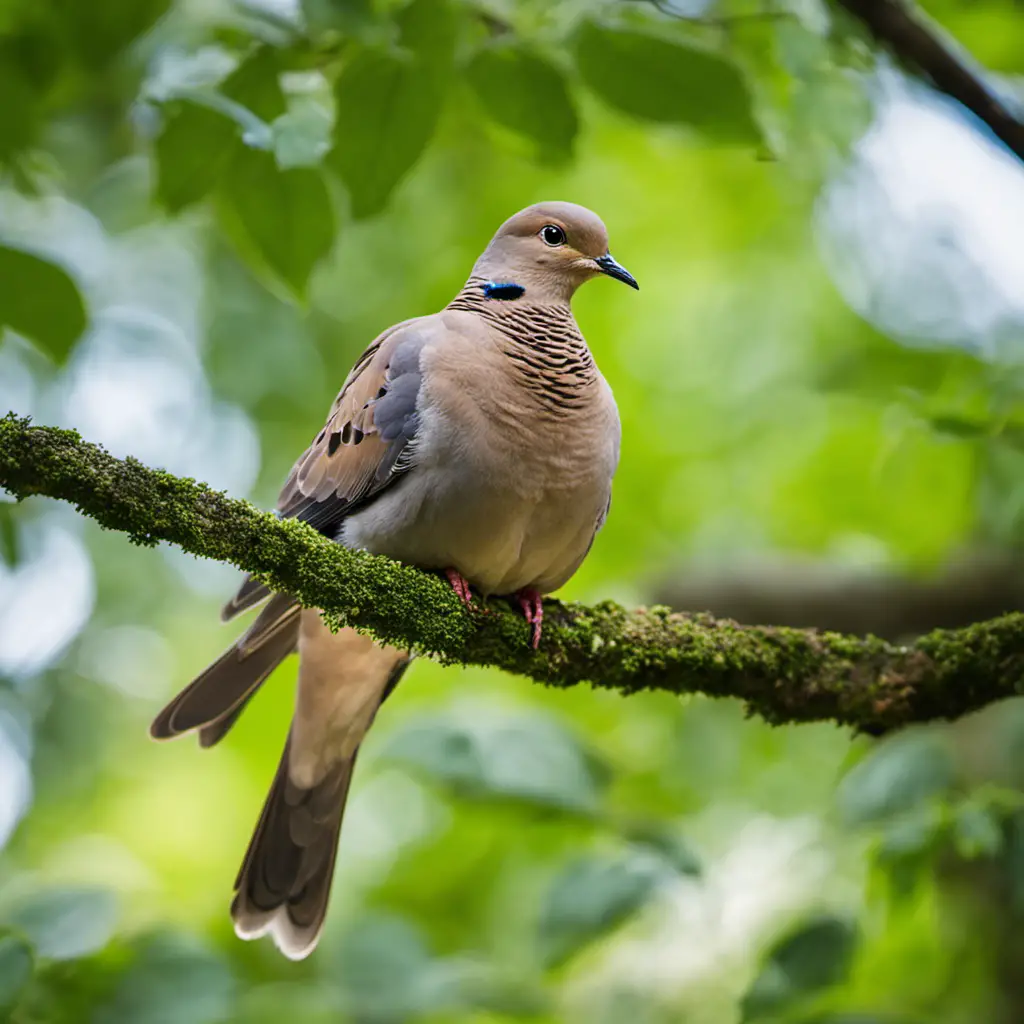
The Mourning Dove is a common sight in Pennsylvania, known for its soft cooing and graceful flight. This bird has specific habitat preferences and interesting breeding behavior.
Habitat Preferences:
Mourning doves are found in a variety of habitats, including open woodlands, agricultural fields, and suburban areas.
They prefer areas with scattered trees or shrubs, providing perching and nesting sites.
They’re often seen near food sources like grain fields and bird feeders.
Breeding Behavior:
Mourning doves form monogamous pairs that mate for life.
Breeding season typically occurs from early spring to late summer.
The male performs a courtship display, where he flies in wide circles while making a distinctive cooing sound.
Understanding the habitat preferences and breeding behavior of the Mourning Dove helps researchers and bird enthusiasts better appreciate and protect this species in Pennsylvania.
American Crow
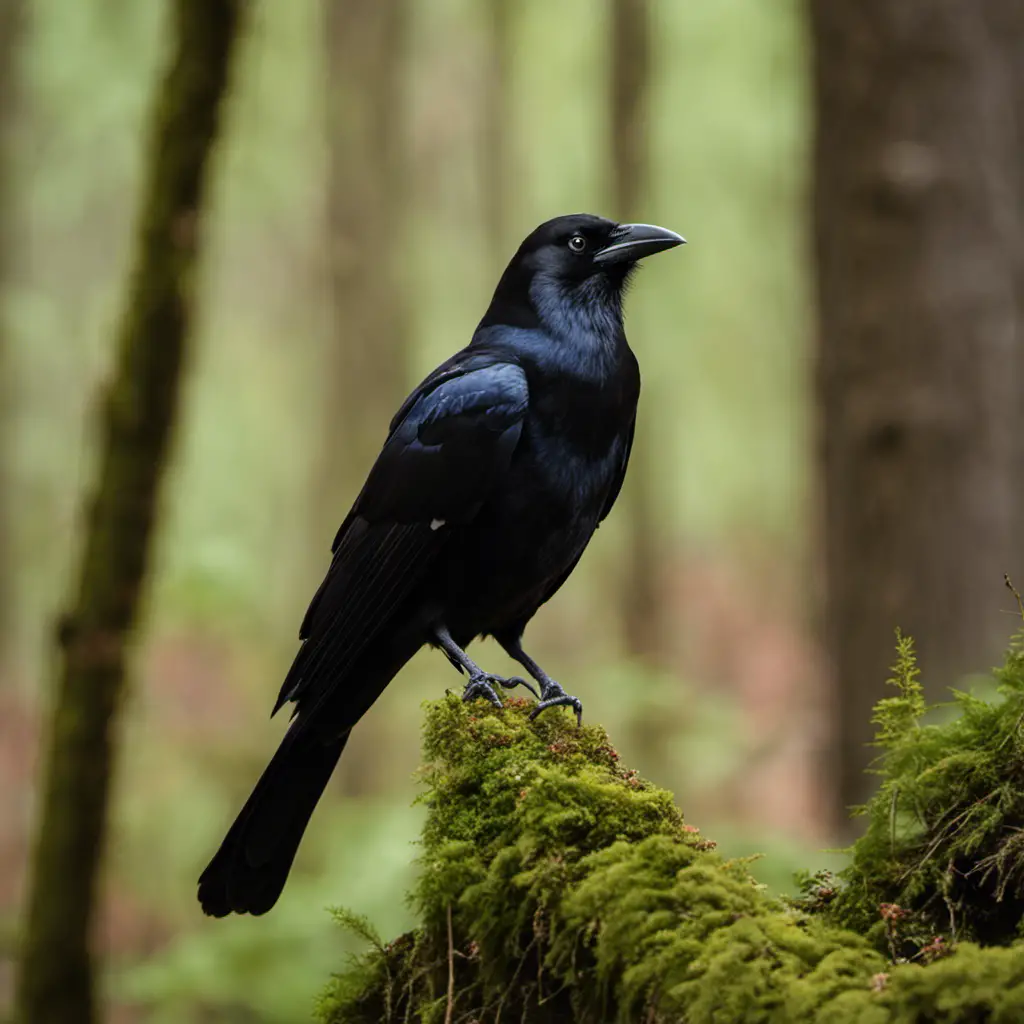
There are many American crows in Pennsylvania, known for their intelligence and adaptability. These highly social birds can be found in a variety of habitats, from urban areas to forests and farmlands. They have a wide range of habitat preferences, allowing them to thrive in diverse environments. American crows are opportunistic feeders, consuming a varied diet that includes insects, fruits, seeds, and small animals. They also exhibit interesting breeding behavior, with pairs usually forming long-term monogamous relationships. Breeding occurs from late winter to early spring, and the female builds a bulky nest made of twigs and lined with softer materials. The female typically lays 3-6 eggs, and both parents participate in incubation and feeding of the chicks. American crows are fascinating birds to observe, displaying remarkable adaptability and complex social behaviors.
| Habitat Preferences | Breeding Behavior |
|---|---|
| Urban areas | Monogamous relationships |
| Forests | Nest building |
| Farmlands | Incubation and feeding |
American Goldfinch
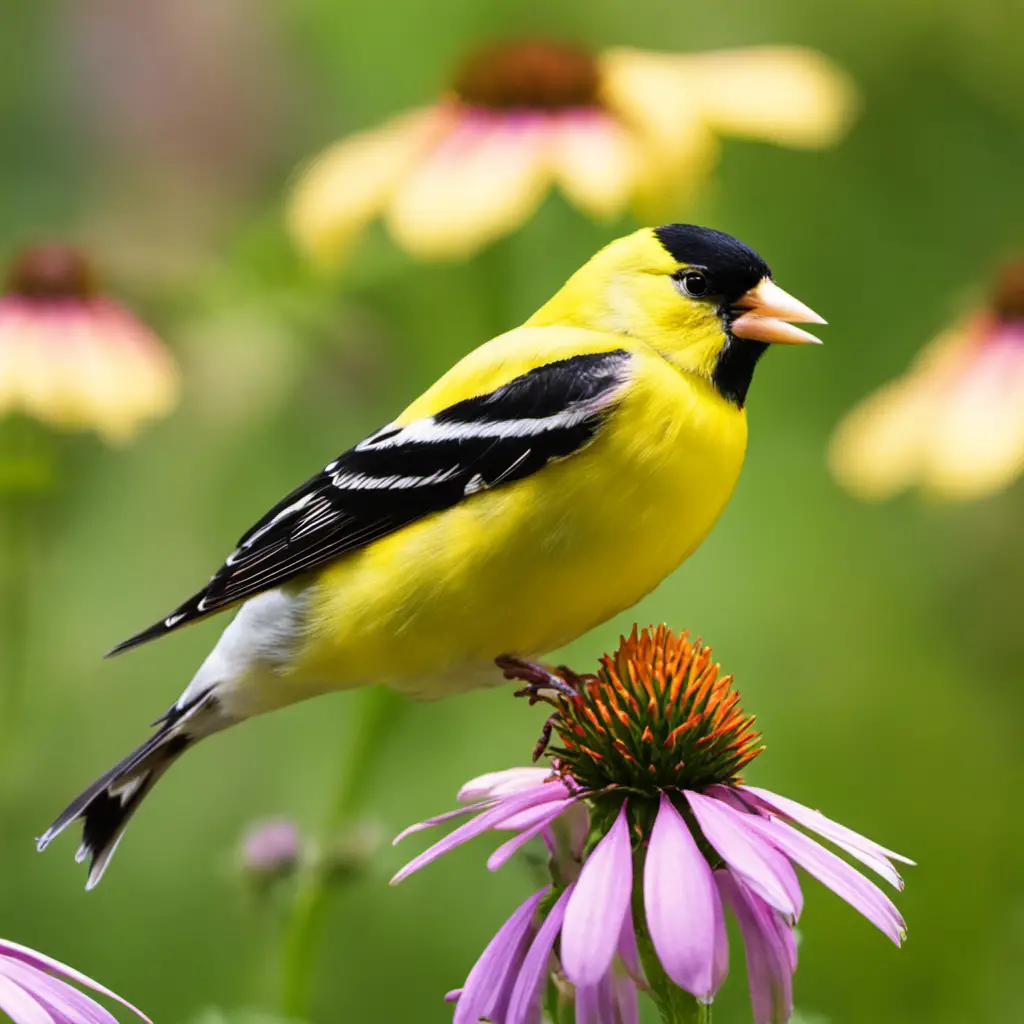
Have you ever seen an American goldfinch up close? These beautiful birds are known for their vibrant yellow plumage and black wings with white markings. They can be found in various habitats across North America, including meadows, fields, and open woodlands. American goldfinches have a unique diet consisting mainly of seeds, especially those of thistles and sunflowers. Their specialized beaks allow them to extract seeds from the plant heads with precision.
When it comes to behaviors, American goldfinches are social birds that often gather in small groups. They’re known for their acrobatic flight patterns and their ability to sing melodious songs. During the mating season, the males display their bright yellow feathers to attract females. Once a pair has formed, they build a cup-shaped nest together. The female lays a clutch of eggs, and both parents take turns incubating them. Once the chicks hatch, both parents share the responsibilities of feeding and caring for the young.
Downy Woodpecker
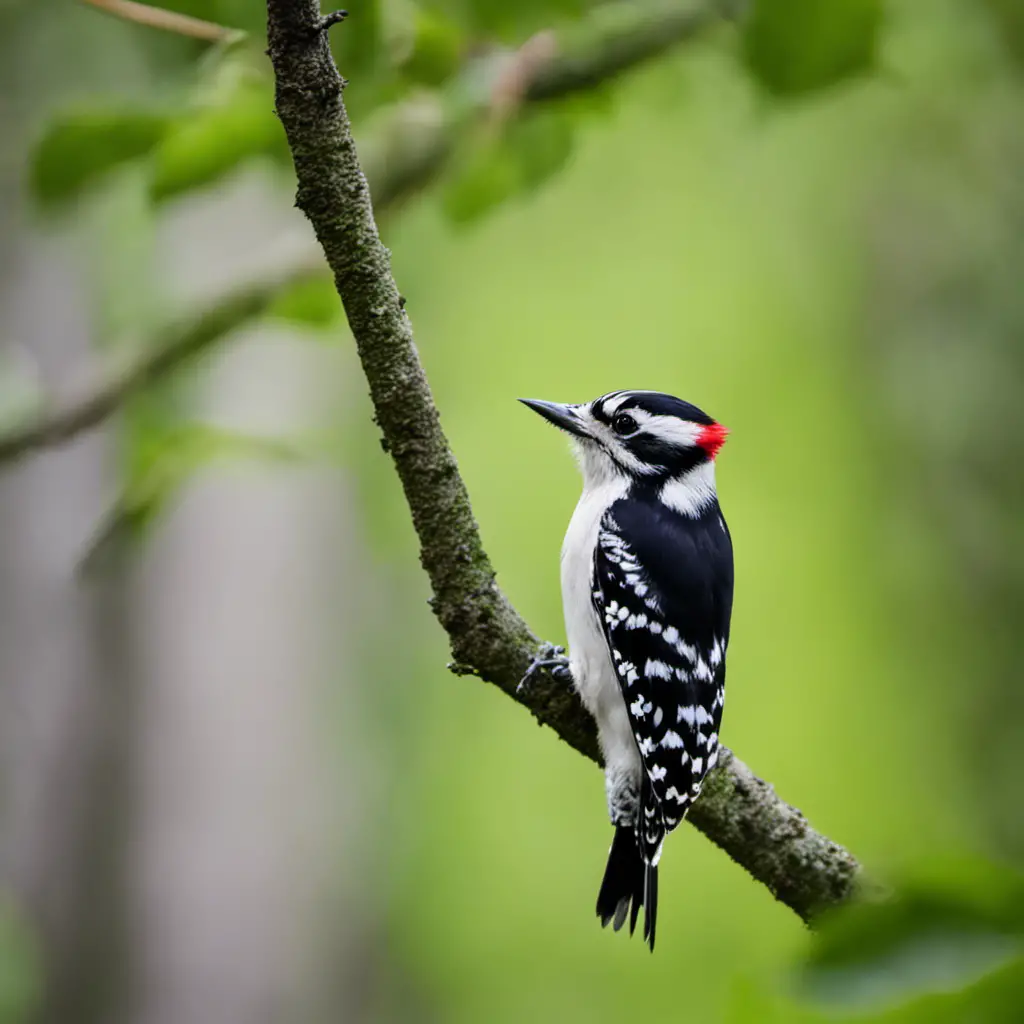
Can you spot a Downy Woodpecker in your backyard, or would you like to learn more about this fascinating bird?
Downy Woodpeckers (Picoides pubescens) are small, black-and-white woodpeckers commonly found across North America, including Pennsylvania. They’re known for their distinctive black and white plumage, with males having a small red patch on the back of their heads. These woodpeckers are about 6-7 inches long and have a wingspan of 9-12 inches.
They’re often seen foraging on tree trunks and branches, using their strong bills to peck at the wood in search of insects. Downy Woodpeckers prefer habitats with a mix of open woodlands, forests, and suburban areas with trees. They’re known for their drumming behavior, which involves rapid pecking on surfaces to establish territory or attract mates.
Keep an eye out for these fascinating birds in your backyard or local parks!
European Starling

You might be surprised to learn that European Starlings, with their iridescent feathers and impressive vocal abilities, are actually an invasive species in North America. Originally introduced in the late 19th century, these birds have since spread across the continent, impacting native bird populations and ecosystems. Understanding their behavior patterns and habitat preferences is crucial in managing their impact.
Behavior Patterns:
- Highly social: European Starlings form large flocks, often numbering in the thousands, which allows them to outcompete native birds for resources.
- Aggressive competitors: They aggressively defend their territories, driving out native species from nesting sites and foraging areas.
- Opportunistic feeders: Starlings consume a wide variety of foods, including insects, fruits, seeds, and even garbage, adapting to diverse habitats.
Habitat Preferences:
- Urban areas: Starlings thrive in cities and suburban areas, taking advantage of human structures for nesting and food sources.
- Open habitats: They prefer open fields, pastures, and agricultural lands, where they find ample foraging opportunities.
- Nesting sites: European Starlings nest in cavities, often displacing native cavity-nesting birds such as woodpeckers and bluebirds.
Understanding the behavior and habitat preferences of European Starlings is essential for effective management strategies to mitigate their impact on native bird populations and ecosystems.
Carolina Wren
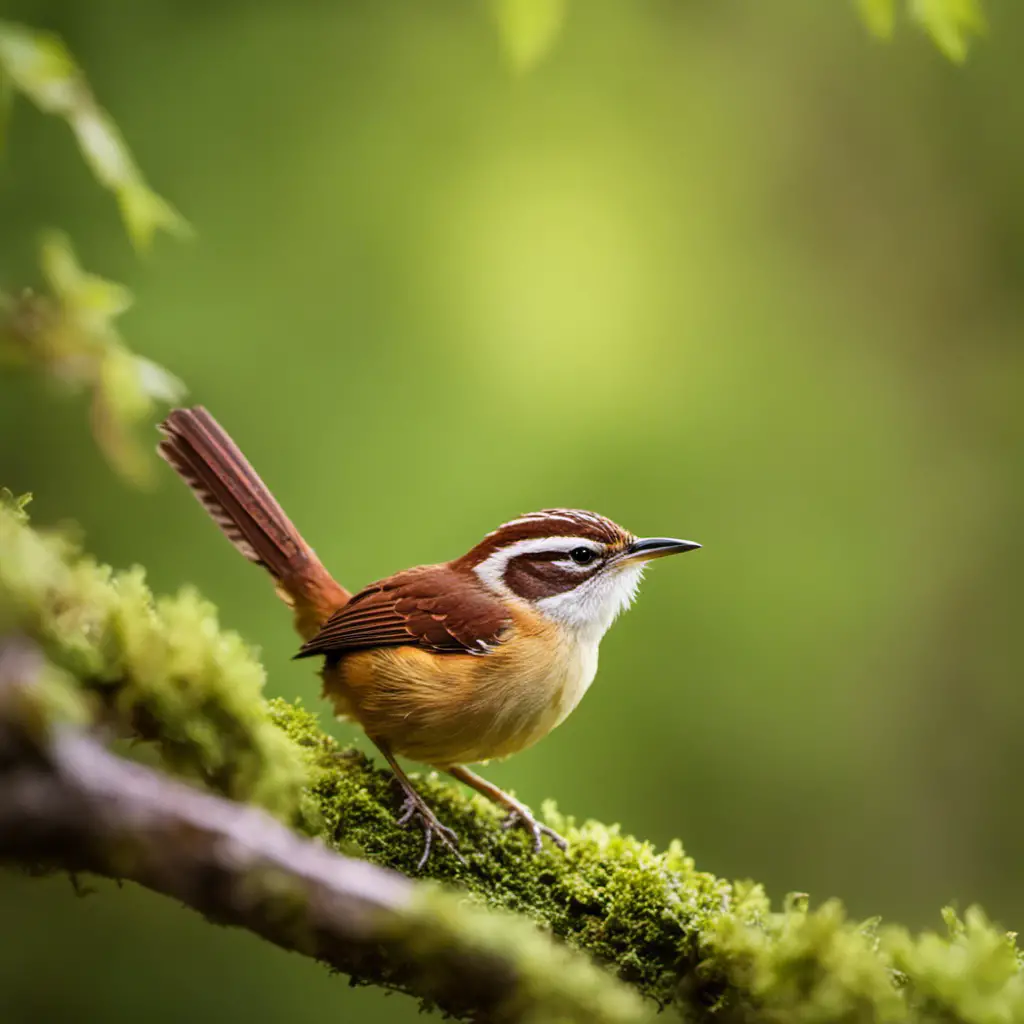
There are several species of birds in Pennsylvania, but the Carolina Wren is one that stands out with its distinctive song. This small bird, measuring around 5-6 inches in length, can be found throughout the state, primarily in dense shrubs, brushy areas, and wooded habitats. The Carolina Wren is known for its loud, melodious song, which can often be heard echoing through the forests.
The Carolina Wren’s diet consists mainly of insects, spiders, and small fruits. It forages on the ground, in trees and shrubs, and even in human-made structures such as garages and sheds.
In terms of reproduction, the Carolina Wren builds a cup-shaped nest in a variety of locations, including tree cavities, birdhouses, and even flowerpots. The female typically lays 3-7 eggs, which are incubated for about 12-16 days. Both parents are actively involved in raising the young, feeding them a diet of insects until they fledge at around 12-16 days old.
| Carolina Wren Facts | |
|---|---|
| Scientific Name | Thryothorus ludovicianus |
| Size | 5-6 inches |
| Habitat | Wooded areas, shrubs, brushy areas |
| Diet | Insects, spiders, small fruits |
| Reproduction | Builds nests in various locations, lays 3-7 eggs, both parents care for young |
Blue Jay
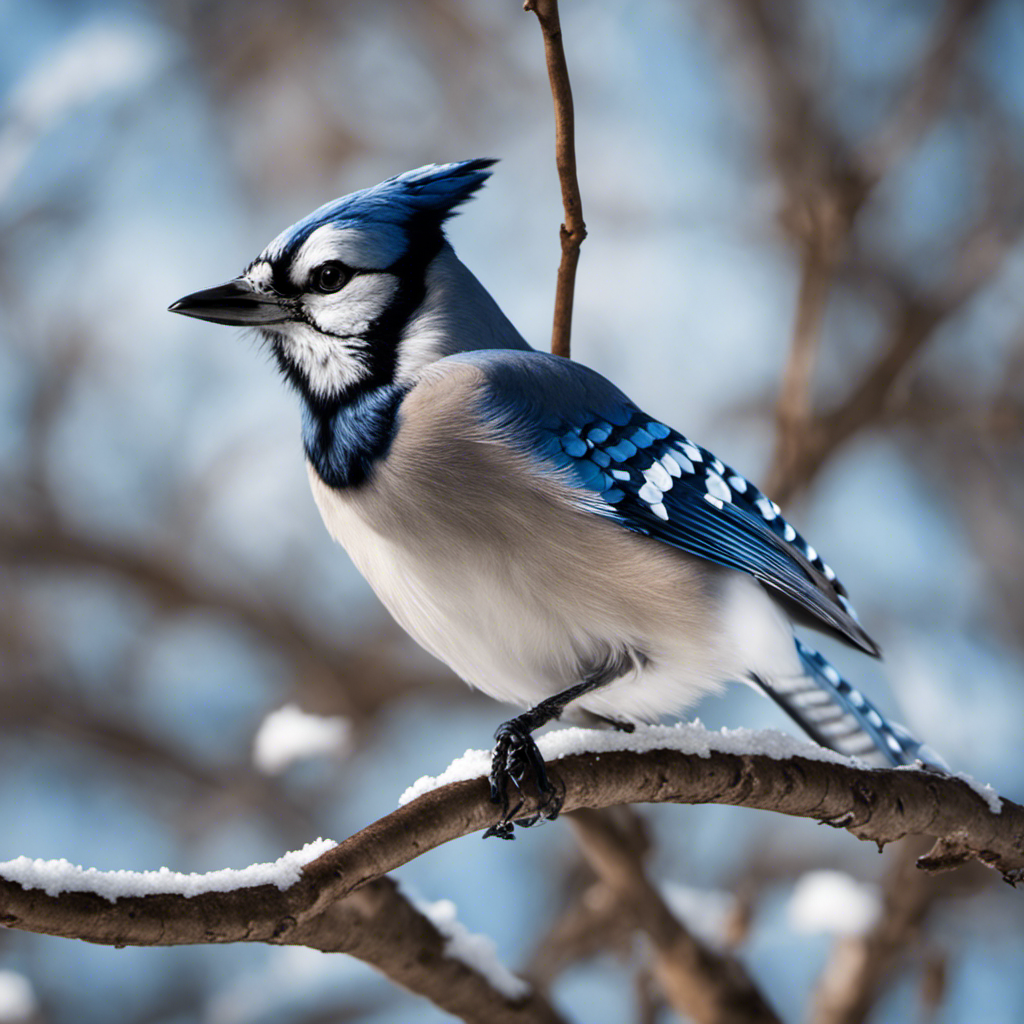
You’ll often hear the loud, distinctive call of a Blue Jay echoing through the trees in Pennsylvania. Blue Jays are known for their vibrant blue and white feathers, making them easily recognizable. Understanding their behavior and diet can shed light on their role in the ecosystem.
Blue Jay Behavior:
- Social birds that often gather in flocks
- Highly vocal, using a wide range of calls for communication
- Known for their aggressive behavior, often defending their territory and nests
Blue Jay Diet:
- Omnivorous birds, feeding on both plants and animals
- Seeds and nuts make up a significant portion of their diet
- They also consume insects, small vertebrates, and even eggs of other birds
House Sparrow
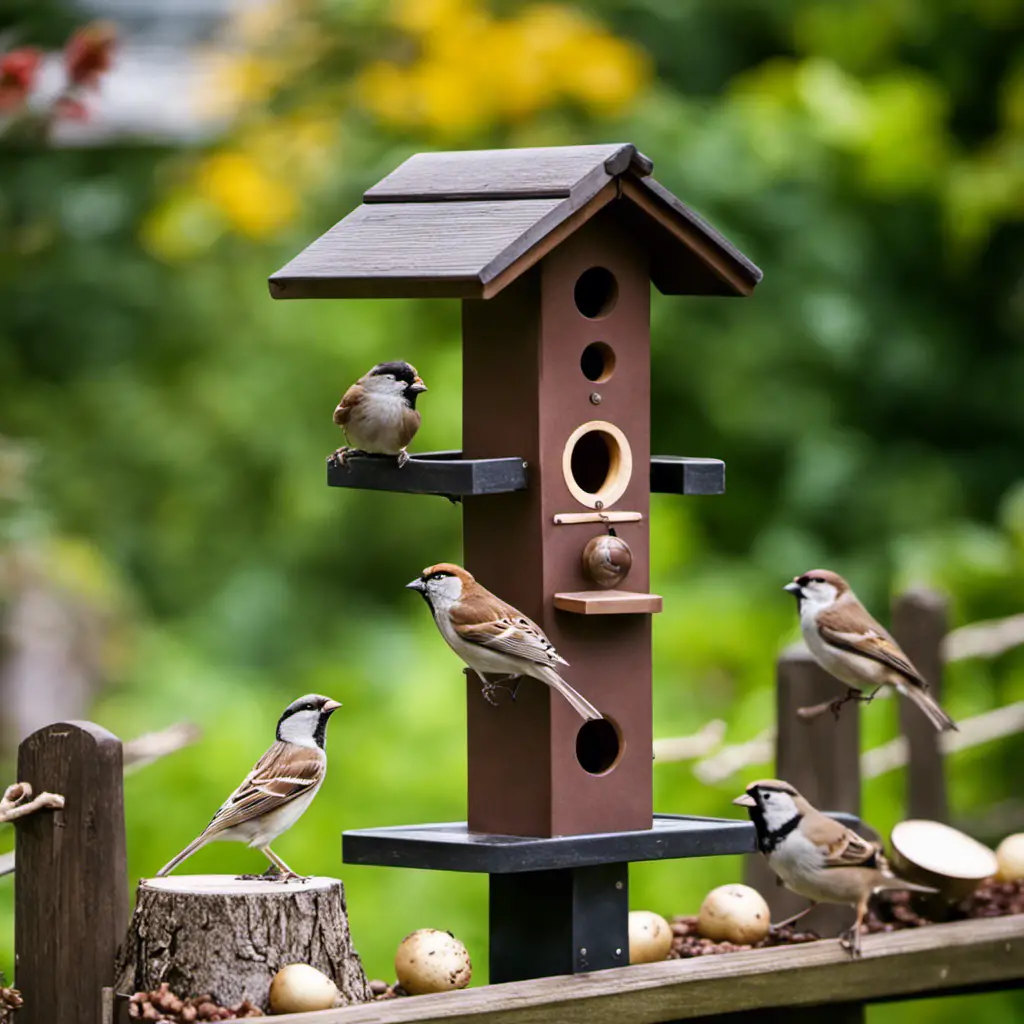
Do you know that the House Sparrow, with its distinctive brown and gray plumage, is a common sight in Pennsylvania? This small passerine bird, also known as Passer domesticus, has successfully adapted to urban environments, making it a familiar species in cities and towns across the state. The House Sparrow is native to Eurasia, but was introduced to North America in the 19th century. Its ability to thrive in urban areas is attributed to its generalist diet, high reproductive rate, and tolerance to human presence. This ecological impact can be seen in the table below, which highlights the House Sparrow’s adaptability and spread in Pennsylvania’s urban landscapes.
| Ecological Impact | Urban Adaptation |
|---|---|
| High reproductive rate | Nests in buildings and urban parks |
| Generalist diet | Feeds on seeds, insects, and human food waste |
| Tolerance to human presence | Thrives in noisy and crowded urban environments |
| Competes with native bird species | Displaces native cavity-nesting birds |
The House Sparrow’s ability to adapt and thrive in urban environments has made it a successful species in Pennsylvania, but its presence can also have negative consequences for native bird species. Understanding the ecology and impact of the House Sparrow is vital for managing and conserving the biodiversity of urban areas.
Red-tailed Hawk

Have you ever seen a Red-tailed Hawk soaring gracefully through the sky, or is it a bird that you have yet to encounter?
The Red-tailed Hawk (Buteo jamaicensis) is a magnificent bird of prey commonly found in North America, including Pennsylvania. This species is known for its distinctive red tail feathers, which become more noticeable as the bird matures. Red-tailed Hawks inhabit a variety of habitats, including forests, grasslands, and open areas. They’re adaptable birds and can be found in both rural and urban environments.
When it comes to behavior, Red-tailed Hawks are skilled hunters, primarily feeding on small mammals such as rodents and rabbits. They’re known for their characteristic soaring flight, using thermal updrafts to effortlessly glide through the air. Additionally, these hawks are monogamous and typically form long-term pair bonds. They build large stick nests in trees or on cliffs, where they raise their young.
Overall, the Red-tailed Hawk’s habitat and behavior make it a fascinating species to observe in the wild.
Red-tailed Hawk habitat:
Forests
Grasslands
Open areas
Red-tailed Hawk behavior:
Skilled hunters
Feed on small mammals
Soaring flight using thermal updrafts
Rock Pigeon

If you look closely, you can spot a Rock Pigeon perched on the ledge of the building across the street.
Rock Pigeons, also known as Columba livia, are a common sight in urban areas due to their adaptable nature. Their natural habitat consists of rocky cliffs and coastal areas, but they’ve successfully colonized cities all over the world.
Rock Pigeons are highly social birds, often seen in large flocks. They communicate through a variety of vocalizations, including cooing and clucking sounds. These birds have a fascinating behavior called ‘head-bobbing’ where they rhythmically move their head up and down. This behavior is believed to be a form of courtship display.
Rock Pigeons are also known for their homing ability and have been used as messengers in the past.
Despite being considered a nuisance by some, these adaptable birds have found a way to thrive in urban environments.
Canada Goose

You might be surprised to learn that there are over 5 million Canada Geese in North America. These iconic birds are known for their V-shaped formations during migration. Understanding the migration patterns of Canada geese is crucial in comprehending their impact on local ecosystems.
The migration patterns of Canada geese can be summarized as follows:
- Seasonal movement: Canada geese migrate seasonally, moving from their breeding grounds in the northern regions to warmer areas during winter.
- Flyway routes: They follow specific flyway routes, which are well-established paths that guide their migration.
- Stopover locations: Canada geese make stopovers at various locations along their migration route to rest and feed before continuing their journey.
The impact of Canada geese on local ecosystems is multifaceted:
- Grazing habits: These birds have a voracious appetite for grass, which can lead to overgrazing and disruption of vegetation in certain areas.
- Water contamination: Their droppings can contribute to high levels of fecal bacteria in water bodies, posing a risk to human health and aquatic life.
- Competition with native species: The presence of Canada geese can outcompete native waterfowl species and disrupt their habitats.
Understanding the migration patterns and impact of Canada geese is essential for managing and conserving local ecosystems.
Mallard
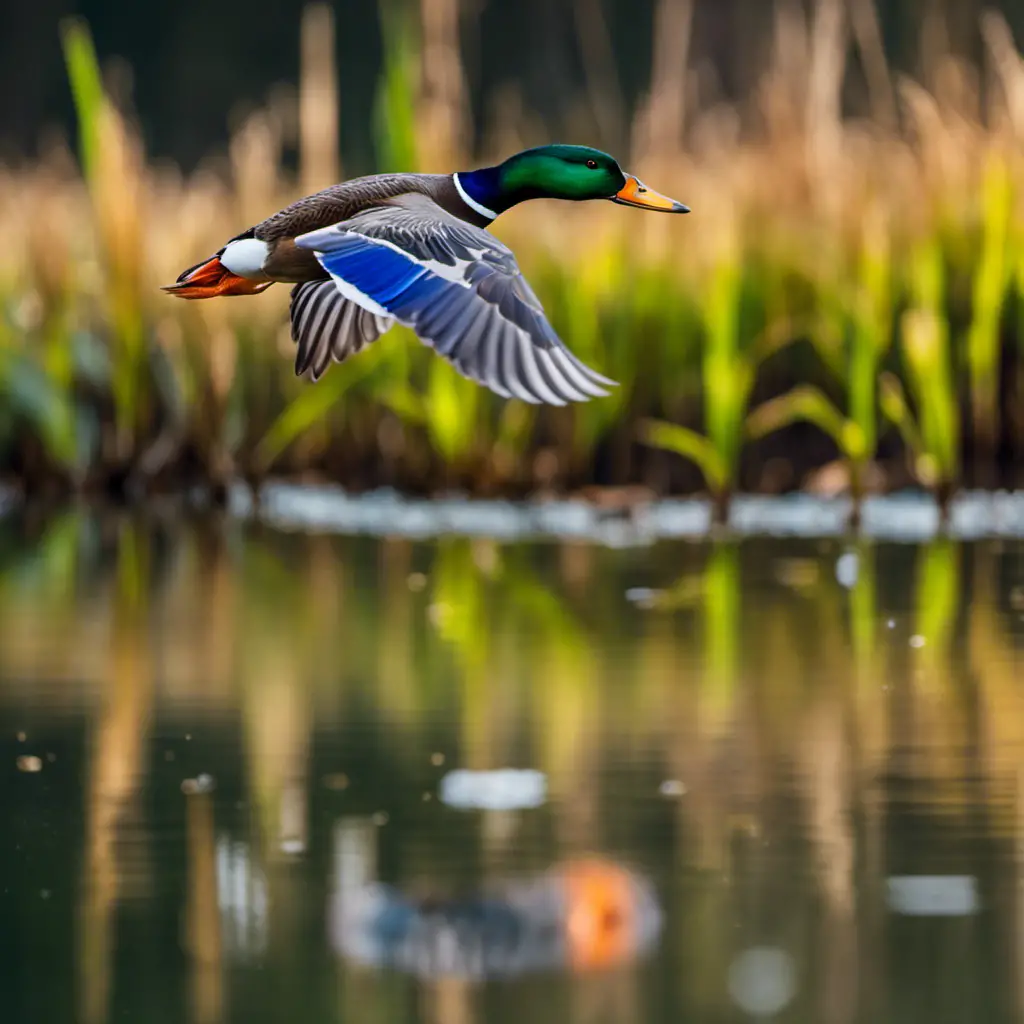
Don’t forget to keep an eye out for mallards near bodies of water, as they are known to swim in and fly over them. Mallards (Anas platyrhynchos) are a common species of dabbling ducks found in North America. They are known for their beautiful green heads, yellow bills, and distinctive white neck ring. Mallards are highly adaptable birds and can be found in a variety of habitats, from marshes and ponds to urban parks and agricultural fields. In Pennsylvania, mallards are commonly seen during bird migration, as they travel to their breeding grounds in the northern regions. During breeding season, mallards exhibit interesting behaviors such as courtship displays and nest building. The table below provides a summary of mallard breeding behaviors.
| Mallard Breeding Behaviors |
|---|
| Courtship displays |
| Nest building |
| Egg laying |
| Incubation |
| Brood rearing |
Song Sparrow

Have you heard the beautiful song of the song sparrow? These small passerine birds are known for their melodic and distinctive songs. Let’s delve into the fascinating world of song sparrows and explore their migration patterns and habitat preferences.
Sparrow Migration Patterns:
Song sparrows are migratory birds, with populations found across North America.
They undertake seasonal migrations, moving from breeding grounds in northern regions to warmer areas during the winter.
Their migration routes vary, but typically follow a north-south pattern.
Sparrow Habitat Preferences:
Song sparrows are adaptable birds, found in a wide range of habitats including grasslands, shrublands, wetlands, and forests.
They’re commonly found near water sources such as rivers, marshes, and ponds.
Song sparrows prefer areas with dense vegetation for nesting and foraging, providing cover and food sources.
Understanding the migration patterns and habitat preferences of song sparrows is crucial for their conservation and management. By studying these aspects, we can ensure the preservation of their populations and maintain the beauty of their songs in our natural environments.
Tufted Titmouse
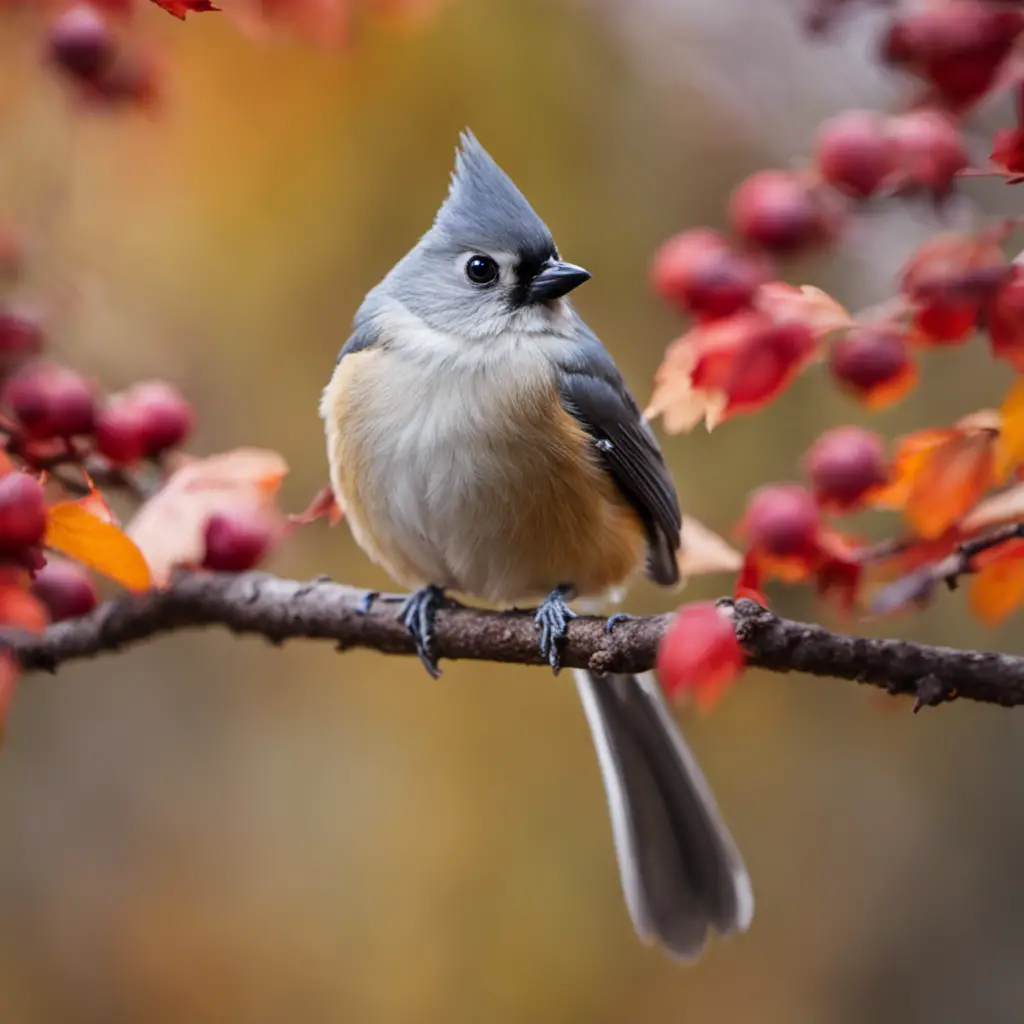
There are several tufted titmice perched on the branches of the tree outside your window, singing their cheerful songs. These small birds are native to Pennsylvania and are known for their distinctive crests and melodious calls. They have a range of behavioral characteristics that make them fascinating to observe. For example, tufted titmice are highly social and often travel in small flocks, communicating with each other through a variety of vocalizations. They are also curious and agile, easily navigating through trees and shrubs in search of food. In terms of habitat preferences, tufted titmice are typically found in deciduous forests and woodlands, where they build their nests in tree cavities. They are adaptable birds and can also be found in suburban areas with suitable tree cover.
| Behavioral Characteristics | Habitat Preferences |
|---|---|
| Highly social | Deciduous forests |
| Curious and agile | Woodlands |
| Communicative | Tree cavities |
| Adaptable | Suburban areas |
White-breasted Nuthatch
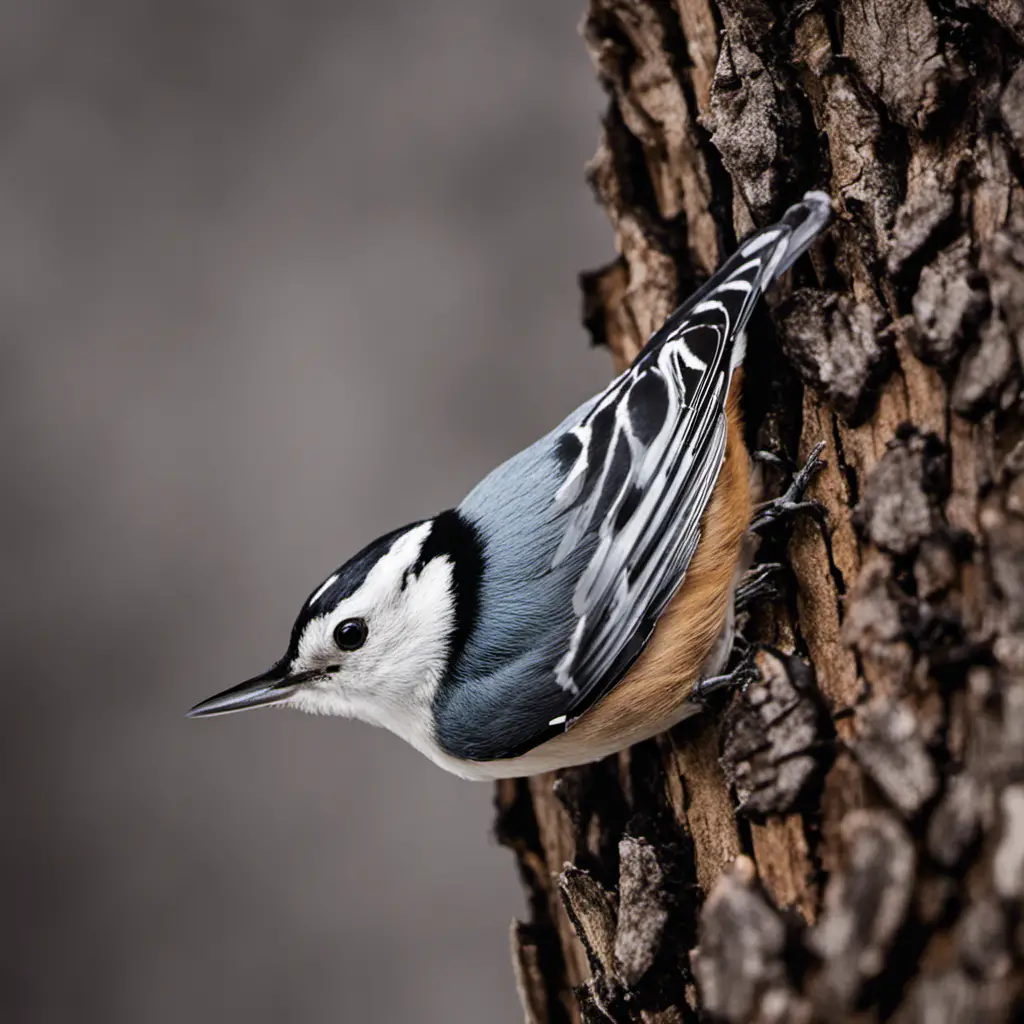
You frequently spot the white-breasted nuthatch as it scurries up and down tree trunks, searching for insects and seeds. This small passerine bird, found in Pennsylvania, exhibits interesting behavior patterns and has specific diet and feeding habits. Here are some key points to understand:
Behavior patterns:
White-breasted nuthatches are known for their unique ability to move headfirst down tree trunks.
They often communicate through nasal calls, which are distinct and can be heard from afar.
These birds are territorial and will defend their nesting areas vigorously.
Diet and feeding habits:
White-breasted nuthatches primarily feed on insects, including beetles, caterpillars, and ants.
They also consume seeds, especially from coniferous trees such as pine cones.
These birds have a habit of wedging seeds in tree crevices, using their bills to hammer them open.
Understanding the behavior patterns and diet of the white-breasted nuthatch allows us to appreciate their unique adaptation and ecological role in Pennsylvania’s avian community.
Common Grackle

Watch out for the Common Grackle as it swoops down to snatch food from your hand. The Common Grackle, scientifically known as Quiscalus quiscula, is a medium-sized blackbird commonly found in North America. Its habitat and behavior are diverse, as it can be seen in various environments, including woodlands, fields, and urban areas. This opportunistic bird is known for its boldness and adaptability, making it a common sight in suburban gardens and parks.
During breeding season, which typically occurs from April to July, the Common Grackle forms large colonies and builds nests near water sources. Males engage in elaborate courtship displays to attract females, showcasing their iridescent plumage and making loud calls. Once mating is successful, the female lays a clutch of 3 to 7 eggs, which she incubates for about two weeks.
In terms of migration patterns, the Common Grackle is known to be a partial migrant. While some individuals migrate south during the winter months, others choose to remain in their breeding territories year-round, especially in urban areas where food is abundant. This adaptability to different climates and food sources contributes to the Common Grackle’s success as a species.
Eastern Bluebird

The Eastern Bluebird is a common sight in Pennsylvania, with its vibrant blue feathers and melodious song. This species can be found in a variety of habitats, including open woodlands, meadows, and suburban areas.
Eastern bluebirds are cavity nesters, meaning they’ll seek out natural or man-made cavities to build their nests. They often compete with other cavity-nesting species, such as tree swallows and house wrens, for suitable nesting sites.
Eastern bluebirds are primarily insectivorous, feeding on a diet of insects, spiders, and other small invertebrates. They’ve also been known to eat berries and fruits when insects are scarce.
During breeding season, male bluebirds engage in territorial displays, defending their chosen nesting site from other males. Females select a mate based on the quality of his territory and his ability to provide food for the chicks.
Overall, the Eastern Bluebird is a fascinating species with unique habitat requirements and interesting behaviors.
House Finch
There are several House Finches chirping outside your window, adding a touch of color to your morning. These small passerine birds, scientifically known as Haemorhous mexicanus, are commonly found throughout North America, including Pennsylvania. House Finches display interesting behavioral traits and have unique diet and feeding habits.
Let’s explore the behavioral traits of House Finches. They are social birds, often seen in flocks, and they communicate through a variety of vocalizations, including melodic songs and chirps. House Finches are also known for their acrobatic flight displays, showcasing their agility and grace.
In terms of diet and feeding habits, House Finches primarily consume plant matter such as seeds, fruits, and buds. They have a specialized bill that is perfectly adapted for cracking open seeds and extracting their nutritious contents. This allows them to thrive in a variety of habitats, including urban areas where they can often be found visiting bird feeders.
To delve deeper into the incredible world of House Finches, let’s take a look at the following table:
| Behavioral Traits | Diet and Feeding Habits |
|---|---|
| Social | Primarily plant matter |
| Vocal communicators | Seeds, fruits, buds |
| Acrobatic flight | Specialized bill |
Black-capped Chickadee
Have you ever heard the distinctive call of a Black-capped Chickadee? These small birds can be found in a variety of habitats across North America, including forests, woodlands, and suburban areas. They’re known for their black cap and bib, white cheeks, and grayish body.
Black-capped Chickadees are highly social birds and often form flocks with other small songbirds. They’ve a varied diet that includes insects, seeds, and berries. These birds are known for their acrobatic behavior, often hanging upside down from branches while foraging for food.
They’re also known for their unique vocalizations, including their famous ‘chick-a-dee-dee-dee’ call, which is used for communication within the flock.
Overall, the black capped chickadee habitat and behavior make them fascinating and important contributors to the ecosystem.
American Kestrel
Do you know that American Kestrels are known for their ability to hover in the air while hunting for prey, and they can also dive down to catch their food? These small falcons are commonly found in open habitats across North America, including Pennsylvania. American Kestrels play an important role in maintaining the balance of ecosystems by controlling the populations of small mammals and insects. Their predatory behavior is fascinating to observe, as they scan the ground from perches or hover mid-air, searching for potential prey. Conservation efforts have been implemented to protect the American Kestrel population, such as providing nest boxes and preserving their habitat. It is crucial to understand and appreciate the ecological significance of these birds, as they contribute to the overall health and diversity of our environment.
| Column 1 | Column 2 | Column 3 |
|---|---|---|
| Common Name | American Kestrel | |
| Scientific Name | Falco sparverius | |
| Habitat | Open landscapes, grasslands, farmland | |
| Conservation Status | Least Concern | |
| Predatory Behavior | Hovering, diving for prey |
Eastern Towhee
Did you know that the Eastern Towhee is easily recognizable by its distinctive ‘drink-your-tea’ call? This bird, scientifically known as Pipilo erythrophthalmus, is commonly found in the eastern part of North America, including Pennsylvania.
The Eastern Towhee has a specific habitat preference, which includes dense thickets, shrubby areas, and forest edges. It can be frequently spotted hopping on the ground, using its strong legs to search for insects, spiders, and seeds.
The Eastern Towhee’s diet consists mainly of insects during the breeding season, but it also consumes seeds and fruits throughout the year. It’s an important seed disperser, helping to maintain the balance of plant species in its habitat.
Understanding the Eastern Towhee’s habitat and diet can contribute to the conservation efforts of this fascinating bird species.
Belted Kingfisher
You can easily spot the belted kingfisher as it perches on a branch and dives into the water to catch its prey. This beautiful bird, native to Pennsylvania, is known for its distinctive appearance and fascinating behavior.
The belted kingfisher is commonly found near bodies of water, such as rivers, lakes, and ponds, where it builds its nests in burrows along the banks. Its habitat also includes coastal areas and estuaries.
With its long, dagger-like bill and strong wings, the belted kingfisher is perfectly adapted to its hunting technique. It hovers above the water, patiently scanning for fish and small aquatic creatures. Once it spots its prey, it plunges headfirst into the water, using its sharp bill to catch its meal.
Despite being a common sight in Pennsylvania, the belted kingfisher’s conservation status is of least concern, as it has a stable population and isn’t currently facing any major threats.
Great Blue Heron
You often see the Great Blue Heron gracefully wading through the water as it searches for fish and other small prey. This majestic bird has specific habitat preferences and interesting breeding behavior.
Habitat Preferences:
Wetlands: Great Blue Herons prefer to live near wetlands such as marshes, swamps, and estuaries. These areas provide an abundant food source and nesting sites.
Standing Water: They’re commonly found near ponds, lakes, and slow-moving rivers, where they can easily catch fish and amphibians.
Coastal Areas: Some Great Blue Herons can also be found along coastal beaches and tidal flats, where they feed on marine invertebrates.
Breeding Behavior:
Colonial Nesting: Great Blue Herons often nest in colonies, called heronries, which can contain hundreds of nests. These heronries are usually located in tall trees near water bodies.
Monogamous Mating: They form monogamous pairs during the breeding season and both parents take part in building the nest, incubating the eggs, and raising the chicks.
Courtship Displays: Males perform elaborate courtship displays to attract females. These displays include stretching their necks, flapping their wings, and snapping their bills.
Understanding the habitat preferences and breeding behavior of the Great Blue Heron provides valuable insights into its ecology and conservation needs.
Frequently Asked Questions
What Is the Average Lifespan of a Northern Cardinal?
The average lifespan of a northern cardinal, a common bird species, is about 3 years. This information is helpful for understanding the life cycle and population dynamics of these birds.
How Do American Crows Communicate With Each Other?
American crows have complex vocalizations and social structure. They communicate through a variety of calls, using different pitches and rhythms to convey messages. Additionally, crows use gestures, such as head bobs and wing displays, for communication within their flock.
What Is the Diet of a Mourning Dove?
The diet of a mourning dove consists primarily of seeds and grains. They are known to eat a variety of plant materials, including corn, sunflower seeds, and wheat. Mourning doves are migratory birds with interesting nesting habits.
How Can You Distinguish Between a Male and Female American Goldfinch?
To distinguish between a male and female American goldfinch, observe their physical characteristics. Males have bright yellow plumage with black wings, while females have a duller yellow color. Breeding behavior in American goldfinches involves courtship displays and nest building.
Where Can You Commonly Find Downy Woodpeckers Nesting?
Downy woodpeckers commonly nest in various habitats like forests, woodlands, and suburban areas. They prefer excavating cavities in dead trees or branches. Understanding their nesting behavior helps in locating their nests.
Conclusion
In conclusion, Pennsylvania is home to a diverse array of bird species.
From the melodious American Robin and vibrant Northern Cardinal, to the tranquil Mourning Dove and intelligent American Crow, these avian inhabitants bring life and color to the state.
The American Goldfinch and American Kestrel showcase their unique beauty, while the Eastern Towhee and Belted Kingfisher add a touch of elegance to Pennsylvania’s avifauna.
Lastly, the majestic presence of the Great Blue Heron adds a sense of grandeur to the state’s birding landscape.

An avid ornithologist, zoologist and biologist with an unwavering passion for birds and wild animals.
Dr. Wilson’s journey in ornithology began in childhood and led him to obtain a Ph.D. in Ornithology from the prestigious Avian Research Institute. He has worked closely with renowned experts in the field and conducted extensive research and field studies globally.
